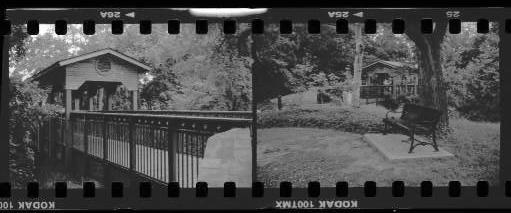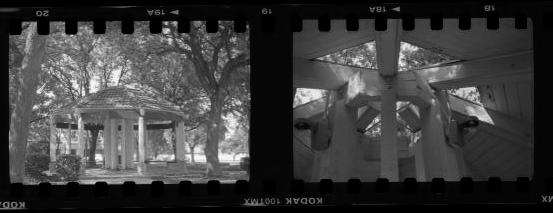Spooling 828 Film
One of the problems in using classic cameras is obtaining film in obsolete formats. For 620 roll film, this isn't too much of a problem since you can just respool 120 film onto 620 spools. For other film formats you have to improvise. One of the easiest to improvise is the 828 roll film format. This is a roll film made by Kodak for the Bantam and Pony 828 cameras. This film format is 35mm wide with 8 exposures of 40x28mm in size.
To spool your own 828 format film, you need the following.
- Two spools
- Backing Paper
- Strip of film
Spools
You need two spools, one for the film and a takeup spool. It is possible to make an 828 spool using a piece of brass or other tubing and two circular pieces of metal, such as a washer, for the flanges. The spool shaft is about 6mm in diameter and 42mm overall length with 35mm in the middle between the flanges for the film. The flanges have a diameter of 19mm and are set back from the ends of the shaft. The flanges on an original spool are less than 1mm thick so the flange is set back about 3mm on each end. The distance you set back the flange would depend on the thickness of the material you use.However, most of the time the camera will come with one spool still in it, so if you obtain two cameras you should have two spools. Given the low cost of these types of cameras, that is usually the best way to go. I was fortunate to purchase a Kodak Pony that had an empty spool in the camera and an undeveloped roll of film still in the box. Along with the spool in a Flash Bantam, I ended up with three spools all together.
Backing Paper
The easiest way to get backing paper is to find an unused or undeveloped roll of 828 film. You can then pull the paper off, discard the film and reuse the paper. You need to be gentle with the paper since it is thin and with age can be brittle. With care, you should be able to reuse the paper many times.
The other possibility is to make a backing paper by cutting down a strip of backing paper from a roll of 120 film. This is what I did. The following diagram shows the dimensions for an 828 roll of eight exposures. (This diagram is for illustration and is obviously not to scale.)

The length of the leader and trailer doesn't need to be exact but needs to be long enough to completely cover the film while loading and unloading the camera. The dimensions shown are very close to the original for 828 film and work just fine. The spacing between frames on 828 film is 45mm. On 120 roll film, the index markers for 4.5 format are spaced 48mm apart. This is slightly larger than original 828 film, but is close enough and has the advantage that you can use the printed numbers for 4.5 format to locate each frame.
Measure from the "1" index mark towards the front of the paper a length of 72mm and make a mark. This is the start of the film. Measure an additional 8in (20cm) from the start of film and cut the paper at that point.
Measure from the "8" index mark towards the end of the paper a length of 72mm and make a mark. This is the end of the film. Measure from the end of the film 7in (18cm) and cut the paper at that point.
You now need to cut the paper to a precise width of 35mm from the top edge of the paper. Cut a diagonal from both ends of the paper back 1in (2.5cm) to make the narrowed ends. This allows the paper to go through the small slot in the spool shaft. The diagram shows tabs on each end like the original film, but this really isn't needed. You can cut to a triangular point and it will work just as well.
Test the paper by trying to roll it up onto a spool. The paper should not bind and should exactly fill the space between the two flanges.
Strip of Film
For film you have two choices. You can take a piece of 120 film and cut it to a width of 35mm. This must be done in the dark and can present a problem. Optionally, you can use 35mm film. If you use 35mm film, you will lose a small part of the image area due to overlap with the sprockets. I used 35mm film.
The length of the strip of film depends on whether you use original 828 paper or you use cut-down 120 paper. Multiply the frame size by ten to get the total film length. For 828 paper, this means you need a strip of film 45cm long. For 120 paper, you need 48cm. One advantage of using 35mm is that you can pull the film out of the cassette as you feed it onto the spool. That way you don't have to cut the film to the proper length first. You can just cut when you reach the appropriate length and then leave the remaining film in the cassette for later use.
Depending on the thickness of the film and backing paper, you may be able to put more than eight exposures on a roll. I used TMax100 and eight exposures would just barely fit. Start with eight exposures first and then see if it is possible to put more on the roll without having the film stick up past the flange.
If you do use 35mm film there may be a problem with the perforations interfering with the film winder on the 828 camera. 828 film has a single hole in front of each frame. On Bantam cameras this hole causes an automatic stop mechanism to get engaged. However, you can usually just hold the release button down and watch the film number window like on a camera without the automatic stop.
Spooling the Film
You need to put some type of indicator at the start of film mark that you can feel in the dark. A paperclip or piece of masking tape will work fine.
Before beginning, cut a piece of masking tape to be used to attach the film to the backing paper.
Begin by inserting the end of the paper in the slot of the spool. Roll up the spool to the point where the end of film mark is just about to meet the spool. At that point, you need to turn the lights off, or use a changing bag. Start feeding the film in underneath the paper and continue until you reach the start of film mark. Cut the film at that point and attach the film to the paper with the piece of masking tape. Continue rolling the paper onto the spool until the paper is completely on the spool. Put a piece of tape on the paper to hold it closed. It's also a good idea to wrap up the spooled film in some aluminum foil or light proof material to prevent any accidental light leaks onto the film should the film become loose and unroll slightly. Optionally, you can just put the film roll into a 35mm film can with a lid. This will keep out stray light just as well.
How well does this work?
This first image is a scan of two frames from a roll I shot in a Flash Bantam. This roll was spooled using the original 828 backing paper. As you can see, the image overlaps the sprocket perforation a little bit, but there is still plenty of image area available. There was also a slight light leak along the edge of the film. I may not have spooled the film tight enough to prevent it from unrolling a little bit. Apart from the fact that I miscalculated and seriously underdeveloped the film, the results are very good.
This second set of frames is from a roll spooled using 120 backing paper. You can see that the spacing between frames is slightly larger but is otherwise the same as the first roll. These images were taken with a Kodak Pony 828

Note that these scans were done at 150 dpi on a flatbed scanner. The actual negatives are sharper.
Other Possibilities
I've described how I created my own 828 film spools, but this isn't the only way to do it. Here are some links to other sites that show spooling 828 film. (Note that linked pages sometimes disappear. I can't help that.)How to make your own 828 film from standard 120 roll film